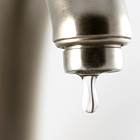For many years I served on one community's Health and Environment Commission. Water Conservation was one large issue on which we worked.
I had the first community xeriscaped yard and brought in the rain barrel concept. We created tiered usage rates, specific watering hours, and had a great array of water saving items available from the water department. Audits were available from the water department as well.
As this problem continues, here are some tips you might wish to use. For main stream media I thought this was quite helpful.
Saving water at home

Where to start:
In order of water savings starting with the most bang for the buck, according to the Rocky Mountain Institute:- Replace water-wasting fixtures with state-of-the-art products, starting with your showerhead.
- Fix a toilet that leaks water from the tank into the bowl, or replace an old toilet with a new "low-flow" model.
- Fix a leaky faucet, replace an inefficient one with a newer model, or add an aerator.
- If you're in the market for a new washing machine, choose one that spins on a vertical axis. (It's probably not cost-effective to replace your conventional machine if it still has a few years left in it.)
- Water your lawn in the morning or evening to reduce water lost to evaporation. Water in pulses of 10-20 minutes with 15 or more minutes in between, allowing the water to soak in properly.
- Redesign your landscape with drought-resistant plants.
More about: Saving water at home
For most households, the vast majority of water is used indoors. You can get the biggest water savings in your home by installing efficient fixtures and fixing leaks.But there are other ways too. Water and electricity are linked; the water-supply sector uses large amounts of energy to transport, treat, and deliver water. On the flip side, vast quantities of water are required to generate power. Use less power and you'll save water, and vice versa.
Food for additional thought: Meat is far more water-intensive to deliver to the table than vegetables. Skip meat once a week at your home, and the water savings upstream is significant.
-
Steam showers: Save water, ease stress
by Linda Merrill for Networx Steam showers are the modern day equivalent of the steam baths of ancient Rome and the traditional Finnish saunas. -
10 things I learned while living without running water
The Green Cheapskate learns the hard way that it's much easier to save resources than he thought. -
Water-wise around the house
The U.S. population nearly doubled between 1950 and 2000; however, the demand for water during that period more than tripled. Americans now use an average of 100 gallons of water every day, enough to fill 1,600 drinking glasses. ... -
Save money and the planet
Five actions you can take that will help to preserve and protect the planet and your budget. -
Raining revolution: Collect rain water, help the planet
Lower your water bills by diverting the water that runs down your roof. -
Fives ways to save time and money on your lawn
Already tired of cutting the grass? These green tips can help. -
Showerhead with automatic shutoff
When you live in Australia, droughts are very real, and water conservation is a part of life. One Australian recently came up with a household invention to help reduce the amount of water being used in the shower. ... -
Clean your car without toxics or water
Cheaper than the car wash and kinder to your water bill, the Eco Touch spray will shine your car without harming the environment. -
Dishpan hands go green
A green strategy for hand-washing your dishes. -
Dry to the bone
A selection of online tips for conserving water -- something much of the U.S. needs to do right now. -
Grey water for flushing
Large-scale projects sometimes install systems to treat and re-use grey water from sinks for flushing toilets. Now, you can do this in your very own home!
No comments:
Post a Comment